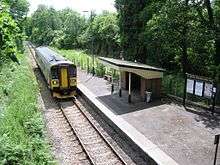St Keyne Wishing Well Halt railway station
| St Keyne Wishing Well Halt | |
|---|---|
 | |
| Location | |
| Place | St Keyne |
| Local authority | Cornwall |
| Coordinates | 50°25′20″N 4°27′49″W / 50.4223°N 4.46368°WCoordinates: 50°25′20″N 4°27′49″W / 50.4223°N 4.46368°W |
| Grid reference | SX251610 |
| Operations | |
| Station code | SKN |
| Managed by | Great Western Railway |
| Number of platforms | 1 |
| DfT category | F2 |
|
Live arrivals/departures, station information and onward connections from National Rail Enquiries | |
| Annual rail passenger usage* | |
| 2012/13 |
|
| 2013/14 |
|
| 2014/15 |
|
| 2015/16 |
|
| 2016/17 |
|
| History | |
| 1902 | opened |
| National Rail – UK railway stations | |
| * Annual estimated passenger usage based on sales of tickets in stated financial year(s) which end or originate at St Keyne Wishing Well Halt from Office of Rail and Road statistics. Methodology may vary year on year. | |
|
| |
St Keyne Wishing Well Halt railway station (Cornish: Gorta Fenten Geyn[1]) is an intermediate station on the scenic Looe Valley Line in Cornwall, United Kingdom. It serves the village of St Keyne and is adjacent to the "Magnificent Music Machines" museum of fairground organs and similar instruments.
It is one of only two stations in the December 2009 official National Rail Timetable (table 140) to have the suffix "halt" (the other being Coombe Junction on the same line). The term "halt" was removed from British Rail timetables and station signs and other official documents by 1974: the return of the term came in 1978 for the opening of IBM Halt in Scotland and in the renaming of these two stations in 2008.
History
The Liskeard and Looe Railway was opened on 27 December 1860 to carry goods traffic; passenger trains started on 11 September 1879. The railway in those days connected with the Liskeard and Caradon Railway at Moorswater, the loop line from Coombe Junction to Liskeard railway station not opening until 25 February 1901, following which St Keyne station opened in October 1902.
Description
The single platform is on the right of trains arriving from Liskeard.
Services

Nearly all trains on the Liskeard to Looe "Looe Valley Line" stop at St Keyne on request – this means that passengers alighting here must tell the conductor that they wish to do so, and those waiting to join must signal clearly to the driver as the train approaches. There is no Sunday service in the winter (November to May).[2]
| Preceding station | Following station | |||
|---|---|---|---|---|
| Coombe Junction Halt or Liskeard |
Great Western Railway Looe Valley Line |
Causeland | ||
Community rail
The railway between Liskeard and Looe is designated as a community rail and is supported by marketing provided by the Devon and Cornwall Rail Partnership. The line is promoted under the "Looe Valley Line" name.
References
- ↑ http://www.magakernow.org.uk/idoc.ashx?docid=f3fabe0c-206f-4e0c-8889-4ce4a5060e5b&version=-1
- ↑ Table 140 National Rail timetable, May 2016
- Beale, Gerry (2000). The Liskeard and Looe Branch. Didcot: Wild Swan Publications Ltd. ISBN 1-874103-47-X.
- Bennett, Alan (1990). The Great Western Railway in East Cornwall. Cheltenham: Runpast Publishing. ISBN 1-870754-11-5.
- Clinker, CR (1963). The Railways of Cornwall 1809 - 1963. Dawlish: David and Charles.
- Cooke, RA (1977). Track Layout Diagrams of the GWR and BR WR, Section 11: East Cornwall. Harwell: RA Cooke.
- MacDermot, E T (1931). History of the Great Western Railway, volume II 1863-1921. London: Great Western Railway.
- Messenger, Michael (2001). Caradon & Looe : the canal, railways and mines. Truro: Twelveheads Press. ISBN 0-906294-46-0.
- Tolson, JM; Roose, G; Whetmath, CFD (1974). Railways of Looe and Caradon. Bracknell: Forge Books.
External links
| Wikimedia Commons has media related to St Keyne railway station. |